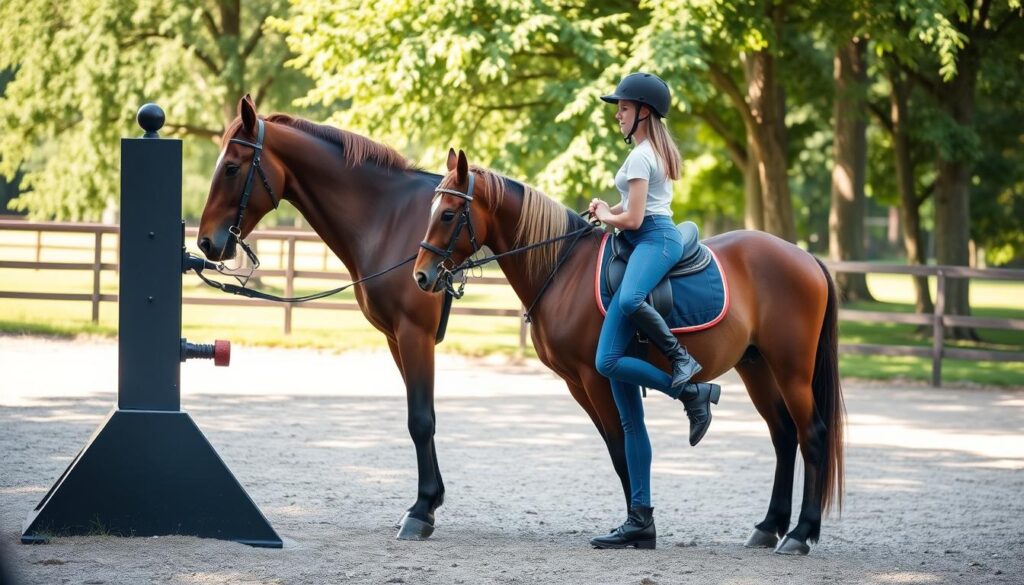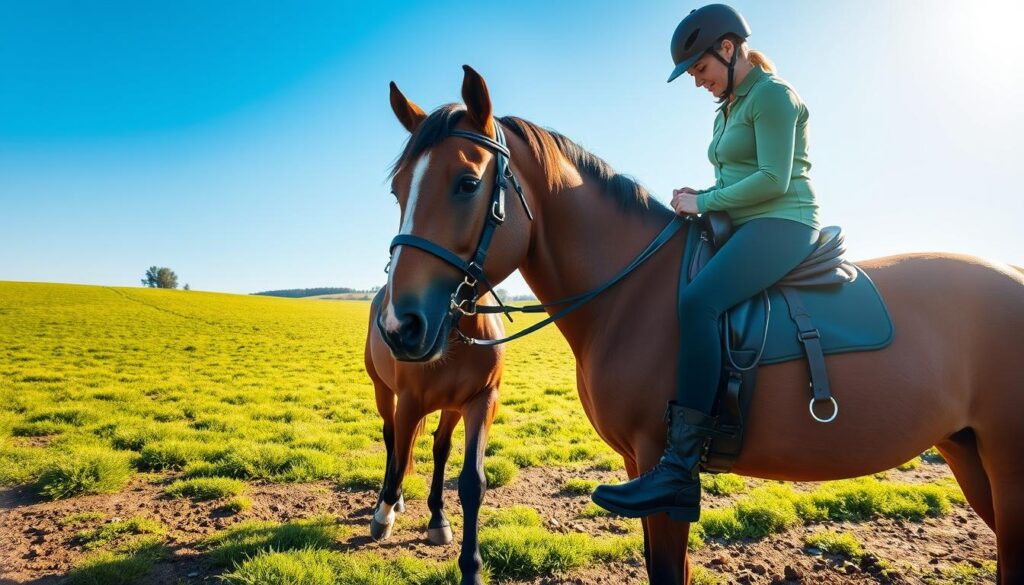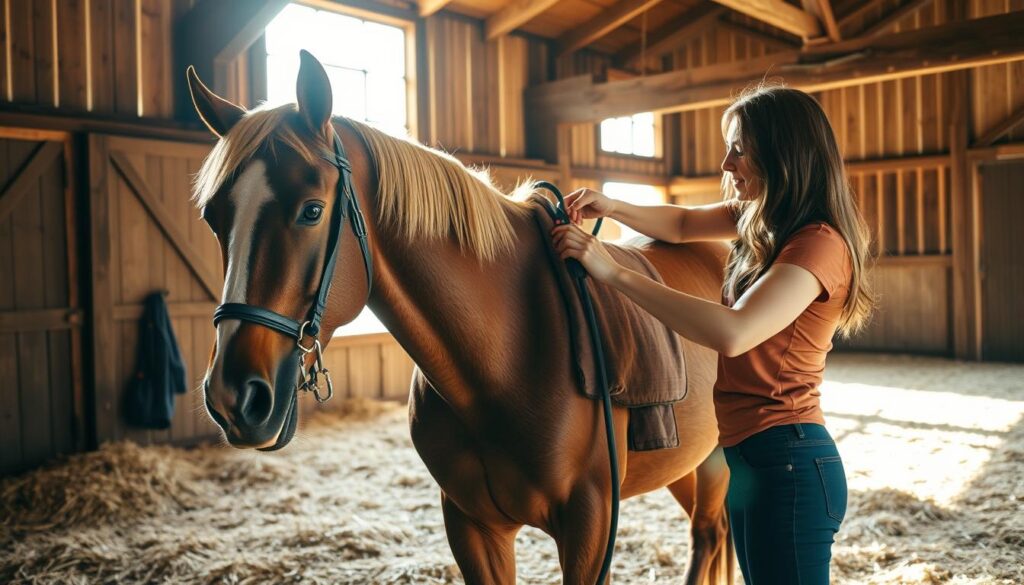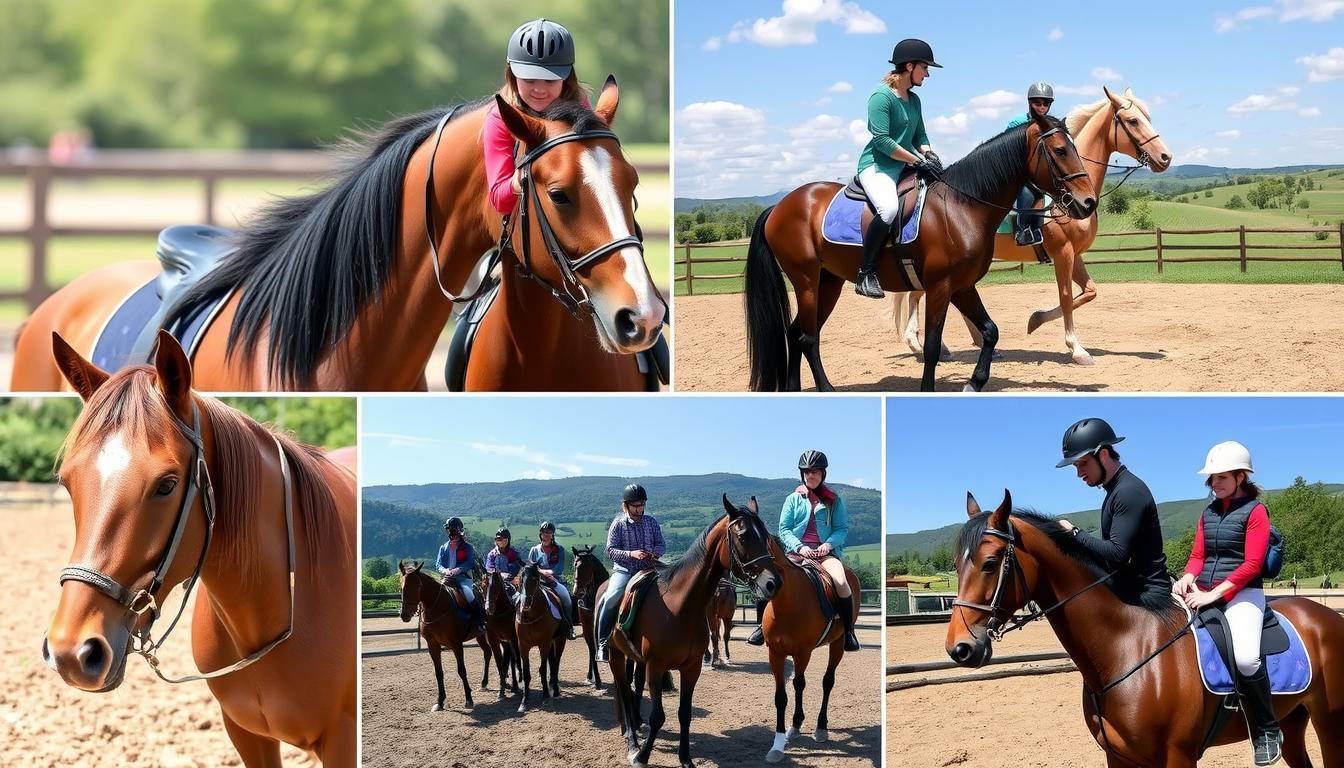Starting out in horseback riding? It’s key to know the common mistakes to stay safe and have fun. Learning about horse behavior, safety, and basic riding skills is vital. This way, you can avoid risks and enjoy your rides more.
With the right knowledge, you can dodge common mistakes. Tips from seasoned riders and instructors can guide you. Knowing what to watch out for makes your riding experience better, whether for fun or competition.
Learning about horse riding and safety sets you up for success. With the right skills, you can enjoy riding while staying safe. Always put safety first and follow advice from trusted sources for a rewarding experience.
Introduction to Safe Horse Riding
Starting your horse riding journey? Safety and education are top priorities. Knowing common mistakes helps you have a good time with your horse. With the right mindset and preparation, you can overcome any challenge in horse riding.
Key Takeaways
- Be aware of common mistakes first-time horse riders make to ensure a safe experience
- Understand horse behavior and safety protocols to minimize risks
- Develop good habits from the start with proper education and preparation
- Prioritize safety and follow horseback riding tips from trusted sources
- Take the time to learn about horse riding and safety to set yourself up for success
- Always prioritize the well-being and safety of both you and your horse
Understanding Horse Psychology: The Foundation of Safe Riding
As a beginner equestrian, knowing horse psychology is key to safety. Horses are smart and have their own personalities. Their actions are shaped by instincts and their surroundings. By understanding these, riders can enjoy a safe and fun ride, avoiding common mistakes.
It’s important to know how horses think and act. Since they are prey animals, they want to run away from danger. Paying attention to their body language helps riders stay safe and avoid accidents.
How Horses Think and React
Horses think and react in their own way. They are very sensitive to what’s around them. By understanding this, riders can communicate better and build trust, making rides safer.
Reading Horse Body Language
Knowing horse body language is crucial for safety. Signs like tense ears or a swishing tail mean they might be scared or upset. Being aware of these helps riders keep their horses calm and safe.
Building Trust With Your Horse
Trust is vital for a good riding experience. It comes from clear communication, being consistent, and respecting your horse’s limits. Building trust means a safer and more enjoyable ride for both.
Essential Safety Gear You Can’t Skip
When it comes to horse riding safety, the right gear is key. Proper horse care starts with making sure the rider has the right equipment. This includes wearing a helmet that meets safety standards to reduce head injury risks.
Riding boots with a low heel and smooth sole are also crucial. Proper footwear helps keep your balance and control. It also prevents your foot from slipping out of the stirrup, which lowers the risk of being dragged or trampled.
Other must-haves include riding gloves and a body protector or vest. Gloves give you grip and protect your hands. A body protector or vest can absorb impact if you fall.
- Helmet certification: Look for a helmet that meets safety standards, such as those set by the American Society for Testing and Materials (ASTM) or the Safety Equipment Institute (SEI).
- Boot quality: Choose riding boots made from high-quality materials that provide support and protection for the feet and ankles.
- Glove features: Select riding gloves that provide a secure grip, protection for the hands, and flexibility for controlling the reins.
Investing in essential safety gear and following proper horse care guidelines can greatly reduce injury risks. This way, riders can enjoy a safe and fun riding experience.
Proper Mounting Techniques for Beginners
Learning to mount a horse is key to basic horsemanship. It needs focus, patience, and practice. As a beginner, knowing how to mount properly is crucial for a safe and fun ride. The right gear can help avoid injuries and build a solid base for your horse riding journey.
When you get close to a horse, pay attention to its body language. A calm horse is easier to mount. Using mounting blocks helps you mount smoothly and confidently. Important steps for mounting include:
- Approach the horse from the left side
- Use a mounting block to ease the horse’s back
- Put your left foot in the stirrup and swing your right leg over
By following these steps and adding basic horsemanship to your routine, you’ll build a strong riding foundation. Always choose the right gear and techniques for a fun and successful ride.

Common Mistakes First-Time Horse Riders Make When Holding the Reins
Holding the reins is key in horse riding. It can greatly affect your experience. Many beginners make mistakes that can lead to accidents. It’s important to know how to hold the reins right and talk to the horse through them.
Some common errors include holding the reins too hard or too soft. This can confuse or upset the horse. Proper rein handling is crucial for control and balance. Gentle and steady rein aids help riders communicate well with their horse and avoid accidents.
- Holding the reins with a firm but gentle grip
- Using subtle rein aids to guide the horse
- Avoiding jerky or abrupt movements
By following these tips, beginners can lower their risk of accidents. They can enjoy a safe and fun ride.
Remember, proper rein handling is essential for effective communication with your horse and avoiding riding accidents. By mastering this skill, you can build trust and confidence with your horse and enjoy a rewarding riding experience.
Body Posture Fundamentals in the Saddle
Good body posture is key for balance, control, and talking to the horse. As a beginner, knowing the basics of horseback riding is vital. It’s important to keep the right posture in the saddle. This means proper weight distribution to stay balanced and talk to the horse well.
Beginners often lean forward or backward, which can upset the horse’s balance. To avoid this, riders should keep a straight line from head to heel. Their head and shoulder position should be relaxed and balanced. For more on common mistakes, check out this resource.
Maintaining Balance
Balance is crucial in horseback riding. Riders should keep their feet in the stirrups and their weight evenly in the saddle. This prevents common mistakes like losing balance or falling off.
Proper Weight Distribution
Proper weight distribution is key for riding. Riders should keep their weight over the saddle, with legs relaxed and balanced. This helps keep balance and talk to the horse well.
Head and Shoulder Position
The position of the head and shoulders is vital for balance and talking to the horse. Riders should keep their head straight and shoulders relaxed and balanced. This keeps a straight line from head to heel, important for riding.
The Right Way to Give Commands to Your Horse
Effective communication is key for horse riding safety and a fun ride. Riders should mix verbal cues with body language. This is a basic skill for every rider.
Using light pressure and clear cues helps avoid confusing or scaring horses. For more on basic horseback riding commands, check online resources. Important commands include moving forward, stopping, turning, and changing gaits.
Understanding horse communication cues is vital for a safe and fun ride. Some key points for giving commands include:
- Using clear and consistent verbal cues
- Applying light pressure with the reins
- Avoiding harsh commands that can confuse or intimidate the horse
By learning these skills and following basic horsemanship skills guidelines, riders can have a safe and enjoyable time with their horses.
Dealing With Emergency Situations on Horseback
Emergency situations can happen even with the best planning. It’s key to know how to act. Staying calm is vital for the safety of both the rider and the horse. Panicking can lead to bad choices, making things worse.
By staying calm, riders can think clearly and act right. This helps solve the emergency.
To avoid accidents, a mix of horse riding techniques and being aware is needed. Riders should always watch their surroundings and their horse’s behavior. This helps spot dangers and signs of trouble. If an emergency happens, follow the right steps for getting off the horse and get help if needed.
Emergency Procedures
- Stay calm and assess the situation
- Follow established emergency dismount procedures
- Seek help from a qualified instructor or emergency services if necessary
Being ready and knowing how to handle emergencies can lower injury risks. This makes horse riding safer and more fun. Remember, avoiding riding accidents is crucial. And horse riding techniques are key to achieving this.
Choosing the Right Horse for Your First Ride
When it comes to horse riding safety, picking the right horse is key, especially for newbies. A good horse for a first-timer ensures a safe and fun ride. Look at the horse’s temperament, size, and experience level.
A calm and gentle horse is best for beginners. Find one that’s well-trained and known for being patient with new riders. The horse’s size matters too; a too-large horse can scare a beginner. Keeping the horse healthy and well-cared for is also vital.
Here are some important traits to look for in a beginner’s horse:
- A calm and gentle temperament
- A smaller to medium size
- Previous experience with beginner riders
- Good training and handling
By focusing on these traits, you can pick a horse that’s perfect for a beginner. Always put horse riding safety and proper horse care first when choosing your first horse.
Pre-Ride Check: Essential Steps Beginners Often Skip
Before every ride, it’s crucial to check the horse, tack, and riding area. This helps prevent accidents and ensures a safe ride. Many beginner equestrian mistakes can be avoided by following simple horseback riding tips. A pre-ride check is an essential step that beginners often skip, but it’s vital for a safe and enjoyable ride.
When it comes to horseback riding, safety should always be the top priority. By following a checklist for pre-ride inspections, riders can minimize the risk of accidents. This ensures a fun experience for both the horse and the rider. For example, a rider can visit relevant websites to learn more about animal care and safety.

- Tack inspection points, such as checking the saddle, bridle, and reins for any signs of wear or damage
- Arena safety assessment, including checking the terrain, obstacles, and weather conditions
- Weather considerations, such as checking the forecast and being aware of any potential hazards like thunderstorms or extreme heat
By following these simple horseback riding tips and avoiding common beginner equestrian mistakes, riders can help ensure a safe and enjoyable ride. Remember to always prioritize safety and take the time to perform a thorough pre-ride check before every ride.
Understanding Different Gaits and Transitions
Learning various horse riding techniques is key for a smooth ride. It’s important to know the different gaits and how to switch between them smoothly. Skills like balance, coordination, and talking to the horse are vital for this.
A horse’s gait is the pattern of its footsteps. The main gaits are walk, trot, and canter. Each gait has its own special features and needs. For example, the walk has four beats, the trot has two, and the canter has three.
To move between gaits, riders use specific aids. These include shifting weight, leg cues, and rein pressure. The goal is to use these aids gently and clearly, so the horse can respond smoothly. With time and effort, riders can get better at handling different gaits and transitions.
Here are some tips for mastering gait transitions:
- Start with slow and gradual transitions
- Use clear and consistent aids
- Practice in a controlled place, like an arena
By following these tips and working on their skills, riders can do better and connect more with their horse.
Building Confidence Without Being Overconfident
As you get better at horseback riding, finding the right balance is key. Being too confident can make you overlook safety. It’s important to build confidence slowly. Start by knowing your limits and those of your horse.
Learning new skills helps build confidence. Mastering new techniques makes you feel more sure of yourself. This also strengthens your bond with your horse, making rides safer and more fun. Remember, patience and persistence are crucial. Take your time and ask for help when you need it.
- Start with short rides and gradually increase the duration as you become more comfortable.
- Practice riding in different environments and conditions to broaden your experience.
- Focus on developing a strong foundation in horse care and management, as this will help you better understand your horse’s needs and behaviors.
By following these horseback riding tips and keeping a balanced approach, you’ll enjoy a safe and rewarding ride. Confidence isn’t about being fearless. It’s about being ready and aware of the risks and challenges of avoiding riding accidents.
Post-Ride Care Mistakes to Avoid
After a ride, it’s key to take care of your horse to keep them healthy. Many riders forget to cool their horses down and don’t give them enough water. Proper horse care means giving them enough water and food, and keeping them clean and groomed. Not doing this can cause dehydration, tiredness, and health issues.
Looking after your horse after a ride is part of horse riding safety. It’s important to cool them down slowly and give them lots of water. This stops dehydration and lowers injury risk. Also, grooming regularly helps remove dirt and sweat, preventing skin problems.

By avoiding these errors and giving proper care, riders can keep their horses healthy. This also lowers the chance of injury or sickness. Remember, horse riding safety isn’t just about the ride. It’s also about the care before and after.
Proper horse care is a critical aspect of horse riding safety, and should not be overlooked. By taking the time to provide adequate care and attention, riders can help ensure a safe and enjoyable ride for both themselves and their horse.
Communication Errors With Your Instructor
Talking well with your horse riding teacher is key for a safe and fun learning time. Many mistakes new riders make come from not talking well. This can cause confusion and frustration for both you and your teacher. It’s important to know how to talk well to avoid these problems.
Some common mistakes include not asking questions, not following directions, and not sharing your thoughts. These can slow down your learning and make accidents more likely. By being open and honest with your teacher, you get the best help and support. This helps you learn the right horse riding skills and avoid common mistakes.
To talk well with your teacher, try these tips:
- Ask questions if you’re unsure about a technique or instruction
- Share your progress and any challenges you’re facing
- Follow instructions carefully and ask for clarification if needed
By using these tips and watching out for common mistakes, you can make your learning better. Remember, good communication is the secret to a great horse riding experience.
By focusing on clear and open talk with your teacher, you can dodge common mistakes. This way, you’ll become a confident and skilled horse rider.
Taking Your Horse Riding Journey to the Next Level
As your horseback riding skills and confidence grow, it’s time to aim higher. The path to improving in horse riding involves pushing yourself while keeping safety first. Look for advanced training to sharpen your basic horsemanship skills and try different riding styles.
Search for clinics, workshops, or private lessons with seasoned instructors. They can offer tailored advice. Topics might include improving your seat, mastering complex moves, and better horse communication. Learning more will make you a better rider and keep you safe in various situations.
The journey of horse riding is endless. Always be open to learning, set achievable goals, and enjoy the journey. With hard work, patience, and a focus on safety, you’ll reach new heights in equestrian skills. You’ll also have amazing times with your horse.
FAQ
Q: What are some common mistakes first-time horse riders make?
A: First-time riders often don’t get horse psychology. They also forget to wear safety gear. They might mount the horse wrong and struggle with reins and posture.
Q: How can beginners understand horse psychology and behavior?
A: Beginners should learn how horses think and react. They need to know how to read body language and build trust. This is key for safe riding.
Q: What essential safety gear should first-time horse riders use?
A: Riders need a good helmet, sturdy boots, and other protective gear. The right equipment prevents injuries and keeps the ride safe.
Q: How can beginners properly mount a horse?
A: To mount right, approach the horse correctly and use mounting blocks. Avoiding common mistakes is crucial for beginners.
Q: What are the common mistakes in rein handling that first-time riders should avoid?
A: Riders often hold reins wrong, leading to accidents. Proper handling is key for control and communication with the horse.
Q: What are the fundamentals of good body posture in the saddle?
A: Balance, weight distribution, and head and shoulder position are key. Good posture helps control and communicate with the horse.
Q: How can beginners effectively communicate with their horse?
A: Use clear cues and body language. Knowing the right commands is essential for a safe and fun ride.
Q: How should beginners handle emergency situations while riding?
A: Stay calm and know how to dismount in emergencies. Being ready for the unexpected prevents accidents and injuries.
Q: How can beginners choose the right horse for their first ride?
A: Consider the horse’s temperament, size, and experience. A suitable horse ensures a safe and enjoyable ride for beginners.
Q: What essential pre-ride checks should beginners not skip?
A: Check the tack and the riding area for safety. Also, consider the weather. These checks prevent accidents and ensure a good ride.
Q: How can beginners learn to understand different horse gaits and transitions?
A: Learn the basics of gaits like walk, trot, and canter. Mastering transitions leads to a more comfortable ride.
Q: How can beginners build confidence without becoming overconfident?
A: Set realistic goals and develop skills gradually. Know when to challenge yourself. Balance is key for safe riding.
Q: What common mistakes should beginners avoid when caring for their horse after a ride?
A: Avoid not cooling down the horse, not watering it enough, and poor grooming. Proper care ensures the horse’s health.
Q: How can beginners communicate effectively with their riding instructor?
A: Clear communication is vital for learning and safety. Avoid not asking questions and not following instructions. Good communication helps in lessons.
Q: How can beginners take their horse riding journey to the next level?
A: Set goals, seek advanced training, and try different disciplines. Keep learning and enjoying to advance your skills.

